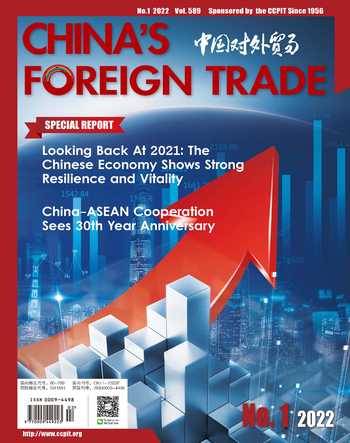China Has Formally Applied to Join CPTPP
By Ada Wong

The resurgence of the COVID-19 pandemic has not only affected the world economy, but has also impacted the global industrial chain and supply chain. In this context, regional trade arrangements have increasingly become an important driving force for economic growth, which explains the active promotions of the RCEP (Regional Comprehensive Economic Partnership), the CPTPP (Comprehensive and Progressive Agreement for Trans-Pacific Partnership), the USMCA (U.S. – Mexico –Canada Agreement), the EU-Japan free trade agreement and the African free trade zone by countries in recent years.
In September, 2021, China’s Ministry of Commerce submitted an application to Zealand to join the CPTPP. With the huge impact that the COVID-19 pandemic is having on global economic recovery, China’s application to join the CPTPP, the world’s largest trader in goods and the largest consumer market will bring both opportunities and challenges. This is not only a major event for China, but also a turning point for the CPTPP.
Promote the economic integration of the Asia-Pacific region
The CPTPP is a free trade agreement signed by 11 countries of Japan, Canada, Australia, Chile, New Zealand, Singapore, Brunei, Malaysia, Vietnam, Mexico and Peru, after the U.S. withdrew from TPP agreement. Having taken effect from December 30, 2018, the CPTPP covers a popu- lation of 498 million and the GDP of member countries combined accounts for about 13% of the world economy.
On November 20, 2020, Chinese President Xi Jinping said during the virtually-held 27th APEC Economic Leaders’ Meeting that China welcomed the signing of the RCEP and would consider joining the CPTPP.
On November 15, 2020, the RCEP agreement was officially signed, signaling the birth of the world’s largest free trade zone, which covers a population of 2.3 billion and accounts for 30% of world GDP.
Zhang Jianping, Director of the Regional Economic Research Center of the Research Institute of the Ministry of Commerce, said that the CPTPP and the RCEP are the two major free trade agreements in the world. During the APEC meeting held in Beijing in 2014, China and other countries jointly formulated the Beijing road map towards the Asia Pacific free trade zone. China’s consideration of joining the CPTPP is a necessary path towards the future Asia Pacific free trade zone and economic integration of the Asia Pacific region.
Expected to inject momentum into China’s opening-up
As an important participant in the global economic system China has been learning the international economic and trade rules through opening-up and promoting domestic reform, from restoring its status of contracting party to GATT to becoming member state of WTO. According to the Legislative Affairs Office of the State Council in 2016, which was 15 years after China’s accession to the WTO, the legislation and reform and abolition of central laws and regulations that had started since 1999 made steady progress. The National People’s Congress and its Standing Committee formulated and revised 21 trade-related laws; the State Council formulated, amended and suspended about 100 relevant administrative laws and regulations; the departments of the State Council formulated, amended and repealed more than 1,000 departmental rules and various policies measures; the local government adjusted about 200,000 rules and regulations.
Such legal amendments have brought true benefits, showing China’s loyalty to its commitments of joining the WTO, and also practical actions to implement such a commitment. Foreign investors are now more able to understand the Chinese market, and are willing to establish business connections with their Chinese business partners.
Compared with the WTO, the rules of the CPTPP are relatively new, and they are expected to push forward the opening-up of China’s economy. Since the beginning of the 21st century, the global economy has been growing rapidly, and technological progress has made more diversified economic and trade cooperation possible. Now the cooperation in the trade in services has been increasing in both scale and depth, but an international trade agreement that coordinates and balances the rights and obligations of all parties has not appeared, which not only hinders the expansion of the business market and reduces the efficiency of innovation, but also brings many risks to all parties along the business chain.
Zhou Mi, researcher of the America and Oceania Research Department of the Research Institute of the Ministry of Commerce, said that the global supply chain has become more unstable, due to the rise of U.S. trade protectionism and the COVID-19 pandemic. Joining the CPTPP will allow member states to reshape the cross-border supply chain and enhance the resilience of the global supply chain, which in the interest of all countries. This will also show that trade agreement negotiations always have big differences. The negotiation for the China-Australia free trade agreement took 10 years, while the China-South Korea free trade agreement only took 2 years. The policies and development concepts differ largely among different countries. The CPTPP also shows such differences as it covers economies of different type and development stages.
China’s proposal to join the CPTPP reflects the need to force China to promote deep reform through high-level opening to the outside world, stimulate new momentum of economic growth, realize the new pattern of dual circulations and cultivate new competitive advantages. The RCEP contains 20 chapters, while the CPTPP features 30 chapters, an increase in both quantity and standards. The CPTPP covers competition policy, intellectual property rights, environmental protection, labor standards, regulatory consistency of state-owned enterprises and other issues. Joining the CPTPP is consistent with China’s innovation-driven development strategy, especially the building of a global high-standard free trade zone network based on China’s periphery region and covering the Belt and Road region. Joining the CPTPP requires China to deepen domestic reform, promote high-level opening to the outside world, and form a new development pattern of domestic-international dual circulations with the domestic circulation as the mainstay.
In the era of digital economy, the international division of labor has made work tasks more specific, economic glo- balization is going deep and forward, and trade in intermediate products trade has become dominant. Under the impact of the COVID-19 pandemic, the stability, openness and efficiency of global and regional supply chains have become extremely important. As one of the world’s most comprehensive industrial systems, the CPTPP will further consolidate the industrial and supply chain with China’s accession. Under the CPTPP, more outbound and inbound investments will be attracted to create a large consumer market. Also, with China’s participation, the CPTPP will enable more intra-industry and inter-industry trade, promote trade in intermediate products and advance the rapid development of digital trade and economy. Only by achieving above goals can the CPTPP truly live up to its reputation and build a real trans-Pacific partnership. China’s accession will not only improve the original regional trade arrangements, consolidate the RCEP and the Asia Pacific Free Trade Agreement, and create synergy between the RCEP and the CPTPP, but also help formulate the global trade rules, and promote regional economic integration and economic globalization.
Experts say that China’s joining of the CPTPP shows that, within the current fragile recovery state of the global economy and the pandemic, China, as the second-largest economy in the world, upholds global free trade, and takes a clear stance against trade protectionism by facilitating free trade and investment. Also, as the world’s largest consumer market, China’s accession to the CPTPP is a big positive for the CPTPP as it will help form a buyer’s market within the member states of the CPTPP, and stimulate the recovery of the world economy. At the same time, the formal submission of a written application for joining the CPTPP also proves China’s firm confidence in joining multilateral trade arrangements, deepening the reform of state-owned enterprises and opening its door wider to the outside world. Joining the CPTPP is also consistent with the development strategy of China’s high-standard free trade zone. It is also an inevitable way to facilitate free trade and investment by reducing tariff and non-tariff barriers, promoting the field of trade in services.
- China’s foreign Trade的其它文章
- Looking Back At 2021:The Chinese Economy Shows Strong Resilience and Vitality
- CCPIT Work Meeting 2021 Is Held Virtually in Beijing
- Joint Effort to Resolve Disputes in Intellectual Property Rights
- Six Industry Opportunities As A Result of Population Change
- Demands for Coal-fired Power Will Reach New High
- IDC’s Top 10 Predictions on China’s ICT Market In 2022

